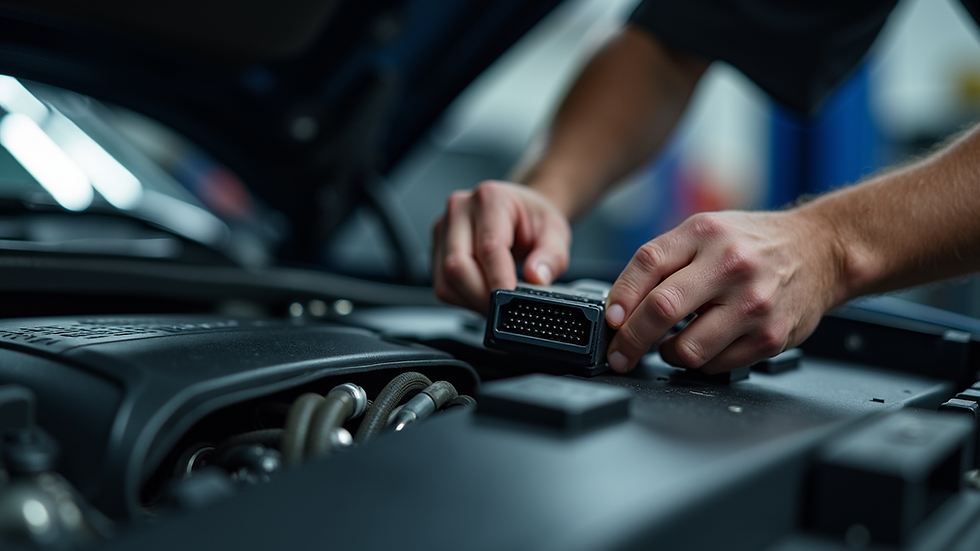Maximize Performance: Affordable Diagnostics for Your Vehicle
- Lincolnshire Remapping

- Aug 9
- 4 min read
When it comes to keeping your vehicle in top shape, understanding its performance is key. Many drivers overlook the importance of regular diagnostics, thinking they are too expensive or unnecessary. However, affordable diagnostics can help you identify issues before they become major problems. This blog post will explore how you can maximize your vehicle's performance without breaking the bank.
Understanding Vehicle Diagnostics
Vehicle diagnostics involve checking various systems in your car to ensure they are functioning properly. This can include the engine, transmission, brakes, and more. By using diagnostic tools, mechanics can pinpoint issues quickly and accurately.
Why Are Diagnostics Important?
Regular diagnostics can save you money in the long run. Here are a few reasons why:
Early Detection: Catching problems early can prevent costly repairs later.
Improved Performance: A well-maintained vehicle runs better and is more fuel-efficient.
Safety: Ensuring your vehicle is in good condition keeps you and your passengers safe.
Affordable Diagnostic Tools
You don’t need to spend a fortune to get your vehicle diagnosed. There are several affordable tools and methods available. Here are some options to consider:
1. OBD-II Scanners
OBD-II scanners are a popular choice for vehicle diagnostics. They connect to your car's onboard computer and read error codes. Many models are available for under $100, making them accessible for most drivers.
How to Use an OBD-II Scanner
Plug it in: Locate the OBD-II port, usually under the dashboard.
Turn on the ignition: You don’t need to start the engine, just turn the key to the "on" position.
Read the codes: Follow the scanner's instructions to retrieve error codes.
2. Smartphone Apps
Many smartphone apps can connect to OBD-II scanners via Bluetooth. These apps provide a user-friendly interface to read codes and monitor vehicle performance. Some popular options include Torque and Car Scanner.
Benefits of Using Apps
Cost-effective: Many apps are free or low-cost.
User-friendly: They often provide detailed explanations of error codes.
Real-time monitoring: You can track your vehicle's performance on the go.
Common Diagnostic Issues
Understanding common issues can help you know what to look for during diagnostics. Here are a few frequent problems that can be identified through diagnostics:
1. Check Engine Light
The check engine light is one of the most common indicators of a problem. It can signal anything from a loose gas cap to a serious engine issue. Using a diagnostic tool can help you determine the exact cause.
2. Brake System Warnings
If your vehicle has a warning light for the brake system, it is crucial to address it immediately. Diagnostics can help identify issues with brake pads, sensors, or fluid levels.
3. Transmission Problems
Transmission issues can be costly if not addressed early. Diagnostics can reveal problems with shifting, fluid leaks, or sensor failures.
DIY Diagnostics
If you're handy with tools, you can perform some basic diagnostics yourself. Here are a few simple steps to get started:
1. Visual Inspections
Regularly check your vehicle for any visible issues. Look for:
Fluid leaks under the car.
Worn or cracked belts and hoses.
Low fluid levels in the engine oil, coolant, and brake fluid.
2. Listen for Unusual Noises
Pay attention to any strange sounds while driving. Grinding, squeaking, or knocking noises can indicate problems that need further investigation.
3. Monitor Performance
Keep track of how your vehicle performs. Notice any changes in acceleration, braking, or fuel efficiency. These can be signs of underlying issues.
When to Seek Professional Help
While DIY diagnostics can be helpful, there are times when you should consult a professional. Here are a few scenarios:
1. Persistent Warning Lights
If a warning light remains on after resetting the OBD-II scanner, it is best to seek professional help. This could indicate a more serious issue.
2. Complex Problems
Some issues require specialized knowledge and tools. If you are unsure about a problem, it is safer to consult a mechanic.
3. Safety Concerns
If you notice any safety-related issues, such as brake problems or steering issues, do not hesitate to seek professional assistance.
The Benefits of Regular Diagnostics
Incorporating regular diagnostics into your vehicle maintenance routine can lead to numerous benefits. Here are some key advantages:
1. Cost Savings
By identifying issues early, you can avoid expensive repairs down the line. Regular diagnostics can help you stay ahead of potential problems.
2. Enhanced Vehicle Lifespan
A well-maintained vehicle lasts longer. Regular diagnostics ensure that all systems are functioning optimally, extending the life of your car.
3. Peace of Mind
Knowing that your vehicle is in good condition provides peace of mind. You can drive confidently, knowing you have taken steps to ensure safety and performance.
Conclusion: Drive Smart, Stay Safe
Maximizing your vehicle's performance doesn't have to be expensive. By utilizing affordable diagnostics, you can keep your car running smoothly and efficiently. Whether you choose to invest in an OBD-II scanner, use smartphone apps, or perform DIY checks, the key is to stay proactive. Regular diagnostics can save you money, enhance safety, and extend the life of your vehicle. So, take charge of your vehicle's health and drive smart.



Comments